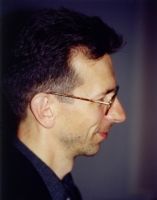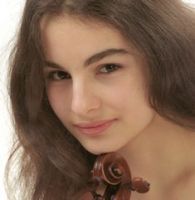Tüür's "Pietas" Timely, Towering at the CSO
Mary Ellyn Hutton
Posted: Sep 26, 2009 - 4:06:53 PM in
reviews_2009

Erkki-Sven Tüür
|
Erkki-Sven Tüür is no stranger to Cincinnati.
The Estonian composer, a lifelong friend of Cincinnati Symphony music director Paavo Järvi, has visited here and several of his compositions have been performed on CSO concerts, including his 1999 "Exodus" with Järvi and the CSO at Carnegie Hall.
Järvi opened the CSO's 115th season Sept. 25 at Music Hall with the U.S. premiere of Tüür's Symphony No.7, "Pietas," featuring the May Festival Chorus.
A co-commission by the CSO and the Frankfurt Radio Orchestra, which premiered it in June of this year, the 40-minute work illustrates Tüür's continuing development as one of the most creative figures in new music today.
Significantly, Tüür (who turns 50 in October) began his musical career as a rock star in his native country. Not satisfied with that, he undertook a thoroughgoing study of composition wherein he absorbed just about every stream that is coursing through the art form today. His objective, he says, is to help bring about a rapprochement between mid-20th century modernism, whose cerebral quality turned off a whole generation of listeners, and the more "accessible" music (including minimalism) that began to assert itself in the 1970s.
Music needs structure, especially to sustain extended works, and Tüür is concerned with both "intellectual" and "emotional" energy, he says. He utilizes a formal technique which he calls "vectorial composition," a term sounding suspiciously like the rigorous methods that left much of the concert audience behind not so long ago. However, as always with great music, the proof is in the listening, and the CSO audience -- a pitifully small one, diminished perhaps by last-week's sold-out gala featuring superstar Lang Lang -- met the test admirably.
As with most concerts featuring new or unfamiliar music, the program was well padded with favorites. Opener, following the National Anthem, was Richard Strauss' "Till Eulenspiegel's Merry Pranks," given a frisky, dead pan reading by Järvi and the CSO. Kudos to principal hornist Elizabeth Freimuth who dispatched the horn solos handily.

Alina Pogostkina
|
Guest artist in Tchaikovsky's Violin Concerto was violinist Alina Pogostkina, winner of the 2005 International Sibelius Competition, in her CSO debut. The evening closed with Russian favorite, Borodin's "Polovtsian Dances" from "Prince Igor."
Strategically, Tüür's "Pietas" was placed second, just before intermission. It is a timely work for our turbulent times and also a challenging one that rewards re-hearing. (It was this listener's second exposure, having attended the dress rehearsal Sept. 24). Scored for large orchestra, it is suffused with color -- astonishingly so -- including a wealth of percussion, to which Tüür ascribes the same importance, he says, as the first violins.
The chorus acts as a commentator on the drama, which is laid out by the instruments. The texts are short, aphoristic quotes from six world historical figures, none of them a god, all concerned with "pietas" (Latin), defined as compassion and ultimately love, said Tüür.
Examples are "We are what we think" (Buddha), "An eye for an eye makes the whole world blind" (ascribed to Mahatma Gandhi) and "The measure of love is to love without measure" (St. Augustine) The work is dedicated to the Dalai Lama.
The texts serve as structural dividers, too, separating the symphony into its four movements, which Tüür calls "waves."
The first wave (movement one) began with a shimmer of flute, glockenspiel and bowed vibraphone (double bass bow drawn up the side of the vibraphone). The double basses sounded a deep drone. The mood was quizzical, with lots of froth and bubbles. The horns entered a semi-tone apart, with muted trumpets and much layering of scalar passages in the winds. It came to a stop before the tenors and basses made the first choral entry with, "We are what we think . . . with our thoughts we make the world."
Gandhi's "You must be the change you see in the world," sung the full choir, followed and was given a gentle halo of solo violin and viola (concertmaster Timothy Lees and visiting principal violist Brian Schen).
Warm strings opened the second wave, and the winds swirled around them. The brasses entered in a combative mood and conflict broke out, with wood blocks, drum set and the sections of the orchestra seemingly pitted against each other. The strings re-entered and the music swelled with stinging discord before the second choral entrance, "When the power of love overcomes the love of power, the world will know peace" (Jimi Hendrix). This was echoed by the string choir and soft touches of tam-tam.
The climate turned ugly as the third wave (which Tüür calls the scherzo) began. The chorus' soft "An eye for an eye . . ." was met by low winds, brass and double basses which coiled vulgarly down against comments by the tuba recalling the dragon Fafner in Wagner's "Ring" cycle. There was cackling in the woodwinds, who also bent their pitches every which way. The Buddha's "Fill your mind with compassion" by the women's voices was set against a swirl of harp and winds, then repeated by the full choir. There was a moment of repose, however, as the brasses blew through their mouthpieces against a shiver of rainstick (percussion). It was like a gust of cool wind and created an extraordinary effect.
(Interestingly, Tüür does not compose at the piano, he said, but like master orchestrator Hector Berlioz in the 19th century, thinks in colors from the beginning of the compositional process.)
Quotes by Augustine, Mother Teresa ("If you judge people, you have no time to love them") and Deepak Chopra ("The less you open your heart to others, the more your heart suffers," sung fortissimo like a reprimand) and a repeat of "Fill your mind with compassion" led into the fourth wave.
The oboes spoke almost pleadingly as the final movement began, reaching into their highest register for a painful, keening effect. The music seemed to ascend, and textures thickened. Another extraordinary effect was percussionist Richard Jensen wielding a claw hammer against "coiled springs" (automobile suspension springs). A world of sound enveloped the listener and became almost majestic at times. The brasses' "wind"/rainstick effect was repeated, creating another soothing moment.
Symbolically perhaps, the chorus and orchestra spoke as one at the end on the Buddha's "We are what we think." Perhaps true unity has been achieved? The texture thinned once again to strings, harp and bowed vibraphone as peace seemed to descend, given a sting, however, by the flutes' blurred final pitch.
Applause was polite (perhaps startled) at first, but grew unanimous as Jarvi invited Tüür to stand with him on the podium.
Russia-born Pogostkina (who now lives in Germany) was a youthful vision (age 26) in a trailing, turqoise gown. As if in character, she gave a sweetly refined performance of the Tchaikovsky Concerto, earning a round of applause at the end of the first movement. The Canzonetta slow movement was slightly accelerated and at times fell to a soft whisper, but she carried on a lovely dialogue with the CSO principal winds. The finale had a winning sparkle and was met by another enthusiastic ovation at the end.
Järvi, the 130-voice May Festival Chorus and CSO waxed exotic in Borodin's "Polovtsian Dances," taken at a clip and calling for some virtuosic playing by the CSO winds. The women with their lilting maidens' dance were a perfect foil for the boisterous men, and the work reached a pitch of fury at the end.
The concert repeats at 8 p.m. Sept. 26 at Music Hall. Northern Kentucky University professor of music Vance Wolverton, a Baltic scholar who has written about Tüür, will speak with him about his work in a pre-concert "Classical Conversation," beginning at 7 p.m. in the Music Hall auditorium.
An abbreviated program comprising Tüür's "Pietas" and the Tchaikovsky Violin Concerto can be heard at 3 p.m. Sept. 27 at Music Hall, followed by an onstage, interactive discussion by Järvi, Tüür and Pogostkina, moderated by Mark Perzel of radio station WGUC, FM 90.9.


